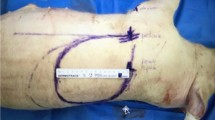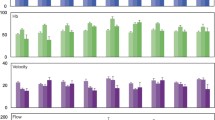Summary
Prolonged ischemia is thought to have detrimental effects on the most vulnerable structure of a free flap, the intima. We investigated experimentally and clinically the effects of ischemia on microvascular flaps, with emphasis on the endothelial cell lining and the efficacy of cold storage solutions in preventing endothelial damage. Experimentally, we investigated three cold storage solutions — the Eurocollins solution, Bretschneider’s solution, and the University of Wisconsin solution — histologically, submicroscopically, and functionally regarding their ability to protect the intima. The University of Wisconsin solution proved superior to the Eurocollins and Bretschneider’s solutions. Our preliminary results on the clinical free flaps confirm a relationship between the duration of ischemia and the secretion of prostacyclin. We therefore recommend that operating teams be organized to allow immediate reanastomosis following free flap elevation. If immediate reanastomosis is not possible, our results indicate that perfusion with the University of Wisconsin solution provides optimal endothelial protection and increases flap viability.
Zusammenfassung
Bei der Verpflanzung freier und mikrovaskulär reanastomosierter Transplantate wirkt sich eine ausgedehnte Ischämiezeit v.a. auf die empfindlichste Struktur des Lappens, nämlich das Endothel, schädigend aus. Mit Hilfe einer experimentellen und klinischen Untersuchung, gingen wir der schädigenden Auswirkung einer Transplantatischämie und der möglichen protektiven Wirkung von Organkonservierungslösungen nach. Drei Lösungen — 1) Eurocollins-Lösung, 2) Bretschneider-Lösung, 3) University-of-Wisconsin-Lösung — wurden histologisch, submikroskopisch und pathophysiologisch in bezug auf ihre endothelprotektive Fähigkeit untersucht. Die University-of-Wisconsin-Lösung erwies sich den anderen Lösungen in jeder Hinsicht als überlegen. Es zeigte sich auch klinisch ein enger Zusammenhang zwischen eer Prostacyclinsekretion und der Dauer der Ischämie. In Anbetracht der aufgezeigten Folgen einer Ischämie empfehlen wir die exakte Planung des Eingriffs, welche eine sofortige Reanastomosierung eines freien Lappens erlaubt. Sollte dies dennoch nicht möglich sein, empfehlen wir die Perfusion mit der University-of-Wisconsin-Lösung, die nach unseren Untersuchungsergebnissen eine ausreichende Endothelprotektion gewährleistet.
Similar content being viewed by others
References
Bohmert HF, von Heßler W (1989) Doppel-seitig gestielter unterer Rektuslappen. In: H Bohmert (eds) Brustkrebs: Organerhaltung und Rekonstruktion Thieme, Stuttgart, pp 333–361
Bretschneider HJ, Helmchen U, Kehrer G (1988) Nierenprotektion. Klin Wochenschr 66:817–827
Cho MJ, Allen MA (1978) Chemical stability of prostacyclin in aqueous solution. Prostaglandins 15:943–954
Collins GM, Bravo-Shugarman N, Terasaki PI (1969) Kidney preservation for transplantation. Lancet II: 1219–1222.
Cooley B, Tadych K, Gould J (1990) Perfusion of free flap with heparinised whole blood during ischemic storage. J Reconstr Microsurg 5: 49–53
Douglas B, Silverman D, Weinberg H (1989) Perfusion washout: increasing a microvascular free flap tolerance to ischemia. J Reconstr Microsurg 5: 151–155
Ebert T, Schmid T, Hengster P, Wödlinger R, Oberhuber G, Weiss H, Herold M, Waldenberger F, Margreiter R (1994) Protective effects of various preservation solutions on cultured endothelial cells. Ann Thorac Surg 58: 489–95
Erhard J, Langer R, Scherer R, Kox WJ, Bretschneider HJ, Gebhard MM, Eigler FW (1994) Comparison of HTK solution versus University of Wisconsin solution for organ preservation in human liver transplantation. Transplant Int 7: 177–181
Erhard J, Daul A, Eigler FW (1995) Organspende und Organkonservierung. Dtsch Arztebl 92: 43–49
Kallerhoff M, Weigel TE, Isemer EE (1991) Ergebnisse der Nierenfunktion nach Transplantation bei Protektion mit Eurocollins, der UW oder der HTK Lösung. Aktuelle Urol 22:310–314
Lamesch P, Hauss J, Rube C, Gubernatis G, Pichelmayer R (1993) Ischaemietoleranz der Leber unter hypothermer Protektion mit der HTK Lösung nach Bretschneider. In: Hagl F (ed) HTK-Lösung nach Bretschneider. Innovations-Verlags-Gesellschaft. Heidelberg, pp 154–164
Mayer B (1990) Intraoperative Protektion freier mikrochirurgischer Transferlappen: „Cold storage” in HTK-Lösung, Laryngorhinootol 69: 549–551
Moncada S, Vane JR (1979) Pharmacology and endogenous roles of prostaglandin endoperoxides, thromboxane A2, and prostacyclin. Pharmacol Rev 30: 293–331
Pegg D (1985) Principles of tissue preservation. In: Morris PJ, Tilney NC (eds) Progress in transplantation. Churchill-Livingstone, Edinburgh, pp 69–105
Author information
Authors and Affiliations
Rights and permissions
About this article
Cite this article
Bschorer, R., Blake, F. & Lisboa, B. Free flap transfer and the prevention of endothelial damage. Mund Kiefer GesichtsChir 1, 235–238 (1997). https://doi.org/10.1007/BF03043556
Published:
Issue Date:
DOI: https://doi.org/10.1007/BF03043556




